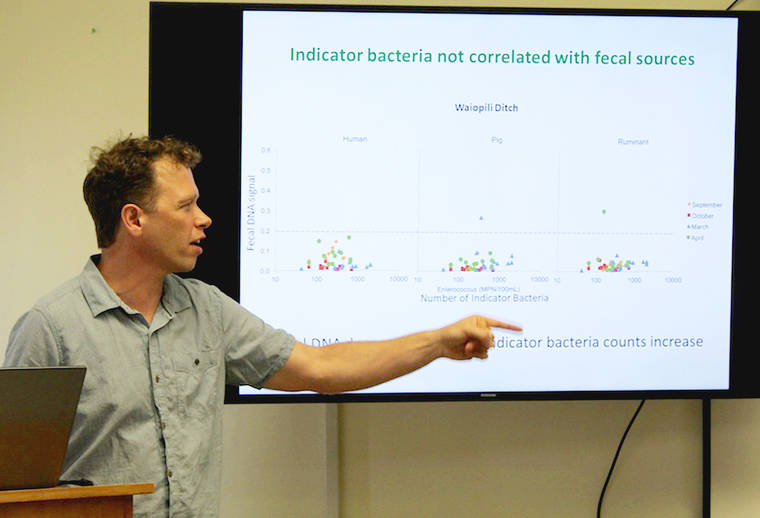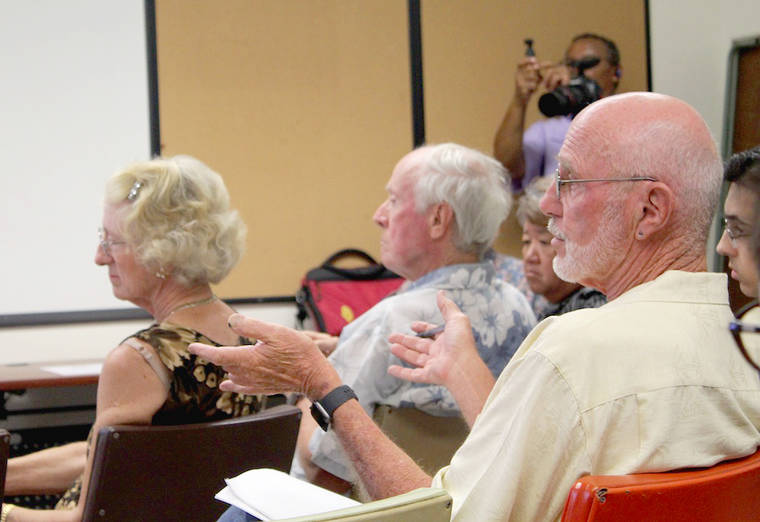LIHUE — Some on Kauai are worried that swimmers could still get sick from the water in the Mahaulepu watershed, even though the state said in June the area does “not pose an imminent health threat to swimmers.’
They also allege the new testing technology used to reach that conclusion was rigged to protect those involved with a now discontinued biosolids dump site in the watershed.
DOH said Thursday the allegations aren’t true.
“No area was avoided,” said DOH environmental health specialist Myron Honda. “Samples were collected using best professional judgment at the time to identify potential pollution sources.”
About 30 people gathered at the Wednesday meeting at the Kauai District Health Office to hear researchers from the Lawrence Berkeley National Laboratory (Berkeley Lab) talk about the microbial tracking tool they developed and its recent results, released in June after a three-year project to complete the study.
In addition to explanations from one of the study’s principal researchers, Eric Dubinsky, Environmental Protection Agency (EPA) manger of the water quality assessment section Janet Hashimoto was present to explain next steps in the project.
She said Hawaii DOH chose to contract Berkeley Lab and their new PhyloChip technology for water testing, but EPA has been closely watching the trial run of the testing method in Hawaii’s tropical climate.
“We are evaluating whether EPA will use PhyloChip as a testing method (for water quality),” Hashimoto said Wednesday.
That’s because tropical soil typically has elevated levels of the bacteria enterococcus occurring naturally in the soil. Those are the fecal indicating bacteria (FIB) detected in traditional water testing methods; they indicate the presence of potential pathogens, they’re not the bugs that make you sick.
PhyloChip could be a more sophisticated testing method for water quality. It could also give Berkeley Lab — the sole developer of the tool — a boost should EPA decide to recommend the method nationwide.
Wednesday, Dubinsky confirmed what DOH already said in their June release about the report: they couldn’t pinpoint the source.
But, researchers did decipher what wasn’t the source of elevated bacteria.
“The goal was to rule out harmful sources of bacteria to tease out the signal from the noise. Is any of this (enterococcus) coming from a fecal source? Is this a harmful source?” Dubinsky said. “Yes, levels of bacteria are high but we saw very little in terms of fecal sources.”
That conclusion was reached by researchers taking local samples from potential sources in the area like wildlife feces and cesspools to calibrate the test and catalogue the DNA fingerprint of those sources. Then they analyze the microbiome of the water sample looking for those “fingerprints.”
They found almost no human fecal sources in the samples — save for one sample with a moderate human signal from the Waikomo Stream and one sample from an injection well in the watershed.
That led to the June DOH statement by health director Bruce Anderson, saying: “high bacteria counts in Mahaulepu Valley, which have been a concern for many years, is not linked to any human sewage sources in the area.”
Some at the meeting pointed out the report’s details of the two human signals found in samples and others brought up neglected areas in sampling with potential harmful that could be producing enterococci — and pathogens.
“Wouldn’t it be prudent to sample the biosolids dump site,” said Bridget Hammerquist, with Friends of Mahaulepu, the group that worked to keep a dairy from setting up in the valley. “Our concern with all of this is the streams have been constantly elevated. Something is feeding it. Wouldn’t it make sense?”
The site was active for 11 years and 269 dry metric tons of waste was deposited there every year during that time.
Dubinsky said they did zero testing within the biosolids dumpsite and didn’t take samples from that area to calibrate their test. When asked whether DOH directed him to stay away from the site Dubinsky didn’t answer the question. Neither did the DOH representatives at the meeting.
Thursday, Honda said none of the samplers were directed to avoid sampling in any location during the study.
“The intent of the study was to understand the surface water quality,” Honda said. “The dump site is about a half mile away from any surface water; however, if contaminants were to be coming from the dump site and traveled to the Waiopili ditch, we took samples down stream and fecal signals would have been detected from that and any other source.”
Dubinsky said the sample sites were selected based on existing DOH testing sites and a survey of the area before the project started.
Carl Berg, Kauai ecologist and senior scientist with the Kauai Surfrider Chapter, said there’s another spot they should be sampling, too, a potential groundwater seep in the Waiopili Stream that could be contaminated with human waste from a nearby cesspool.
“There’s a groundwater seep at the Surfrider sample spot, could be connected to the Gillin’s (Beach House) cesspool,” Berg said.
While there wasn’t any talk of adding more data to the existing PhyloChip test results, Hashimoto said there is a next step in motion and that’s to do a quantitative microbial risk assessment.
The test ruled out the potentially harmful fecal sources of enterococci in the water, the next step is to understand the risk of disease, even with the high presence of the bacteria.
“We want to look for pathogens associated with the indicator bacteria. How much risk would it pose even if it’s not human? That’s the next step we’d like to venture into,” Hashimoto said.
•••
Jessica Else, environment reporter, can be reached at 245-0452 or jelse@thegardenisland.com.



